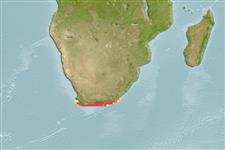Elasmobranchii (sharks and rays) >
Carcharhiniformes (Ground sharks) >
Pentanchidae (Deepwater catsharks)
Etymology: Halaelurus: halos (Gr.), sea; ailouros (Gr.), cat, probably an allusion to the vernacular “catshark,” so named for its cat-like eyes (See ETYFish); natalensis: -ensis, Latin suffix denoting place: the coast of Natal, South Africa, type locality (See ETYFish).
More on author: Regan.
Environment: milieu / climate zone / depth range / distribution range
Ecology
Marine; demersal; depth range 0 - 172 m (Ref. 5578). Subtropical; 33°S - 35°S
Southeast Atlantic: Cape Agulhas to East London in South Africa. Until recently, two species were confused under this name, the present one and the recently described Halaelurus lineatus (Ref. 244).
Size / Weight / Age
Maturity: Lm ? range ? - ? cm
Max length : 45.0 cm TL male/unsexed; (Ref. 244); 47.0 cm TL (female)
Dorsal spines (total): 0; Anal spines: 0. A catshark with a prominent upturned knob on the snout, a broad head, and with no spots on the body (Ref. 5578). Yellow-brown in color, with pairs of broad, vertical, dark brown stripes outlining dusky saddles (Ref. 5578), cream ventrally (Ref. 5510).
Found on the continental shelf, from close inshore to deeper water (Ref. 244). Feeds mainly on small bony fishes and crustaceans, also cephalopods and small elasmobranchs (Ref. 244).
Life cycle and mating behavior
Maturity | Reproduction | Spawning | Eggs | Fecundity | Larvae
Oviparous, with 6 to 11 egg-cases per oviduct (commonly 6 to 9) at a time (Ref. 244). Egg cases retained until embryos are well-advanced (Ref. 5578).
Compagno, L.J.V., 1984. FAO Species Catalogue. Vol. 4. Sharks of the world. An annotated and illustrated catalogue of shark species known to date. Part 2 - Carcharhiniformes. FAO Fish. Synop. 125(4/2):251-655. Rome: FAO. (Ref. 244)
IUCN Red List Status (Ref. 130435: Version 2024-2)
Threat to humans
Harmless
Human uses
Fisheries: subsistence fisheries; gamefish: yes
Tools
Special reports
Download XML
Internet sources
Estimates based on models
Preferred temperature (Ref.
123201): 15.7 - 21.9, mean 18 °C (based on 30 cells).
Phylogenetic diversity index (Ref.
82804): PD
50 = 0.5078 [Uniqueness, from 0.5 = low to 2.0 = high].
Bayesian length-weight: a=0.00355 (0.00175 - 0.00721), b=3.08 (2.90 - 3.26), in cm total length, based on LWR estimates for this (Sub)family-body shape (Ref.
93245).
Trophic level (Ref.
69278): 4.2 ±0.4 se; based on diet studies.
Resilience (Ref.
120179): Low, minimum population doubling time 4.5 - 14 years (Fec assumed to be <100).
Fishing Vulnerability (Ref.
59153): Moderate vulnerability (37 of 100).
